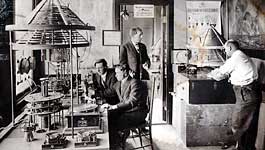Read Mike Cassidy's Story in the Mercury News | Watch the Complete Herrold Documentary
Below, a recreation of a Herrold broadcast from the PBS documentary "Broadcasting's Forgotten Father: The Charles Herrold Story"
IMAGINE A CHARLES HERROLD BROADCAST
Below is an overly
simplistic view of a Herrold broadcast as it might have happened in 1912

|
HERROLD STUDENTS "ON THE AIR" In radio broadcasting, sound in the form of voice and music, is transmitted from a studio to your home or car radio. Every modern radio works about the same way regardless if it's a cheap low model brand or even more expensive ones you might get through an equipment lease. This is the Herrold "on air studio," all analogue, circa 1913: 1. Grooves on
spinning record vibrate needle & diaphragm |

|
 |
 |
 |
|
|
|
|||

|

|
|
The final element needed for broadcasting is the audience. During the time of the Herrold broadcasts, 1909 - 1917, most radio transmission was Morse code, a single sender and a single known receiver. Herrold's audience were mostly young experimenters and set builders, their friends and parents, and students of the Herrold College. In the days before modern electronics they listened on headphones connected to crystal detector and coil, antenna and ground. |

|
||